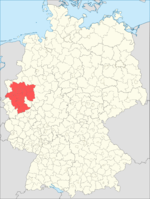Museum zur Vorgeschichte des Films
1900s architectureBuildings and structures completed in 1904Film archivesMuseums established in 2006Round towers ... and 2 more
Technology museums in GermanyWater towers in Germany

The Museum zur Vorgeschichte des Films (English: Museum of the Prehistory of Film) is a permanent exhibition on the development of moving images before the invention of cinematography. Together with the world's largest walk-in camera obscura, the museum is housed in a 25.5 m high water tower in the Broich district of Mülheim. Together with the neighbouring roundhouse, the water tower is part of the Industrial Heritage Trail.
Excerpt from the Wikipedia article Museum zur Vorgeschichte des Films (License: CC BY-SA 3.0, Authors, Images).Museum zur Vorgeschichte des Films
Am Schloß Broich, Mülheim an der Ruhr Broich (Linksruhr)
Geographical coordinates (GPS) Address Website Nearby Places Show on map
Geographical coordinates (GPS)
| Latitude | Longitude |
|---|---|
| N 51.4291 ° | E 6.86818 ° |
Address
MüGa - Mülheimer Landesgartenschau (Mülheims Garten an der Ruhr)
Am Schloß Broich
45479 Mülheim an der Ruhr, Broich (Linksruhr)
North Rhine-Westphalia, Germany
Open on Google Maps









